-
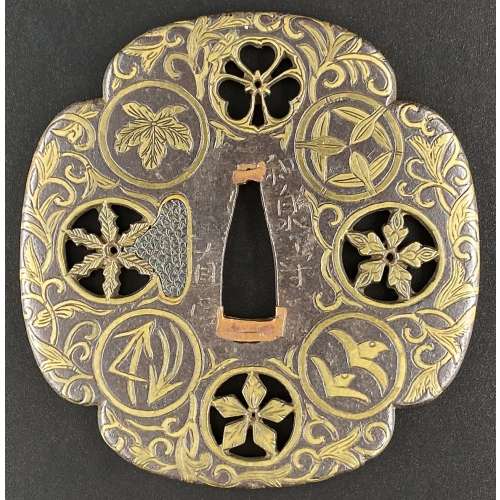 The so-called Yoshirō-tsuba [与四郎鐔] with an iron plate of mokkō form densely decorated with floral arabesque and adorned with eight pierced, chiselled and inlaid brass roundels and signed on both sides 'Koike Yoshirō Izumi no Kami Naomasa'. Four of the roundels are pierced and have geometrical designs representing flowers (e.g. wood sorrel) or snowflakes. Four others are solid and represent family crests; on one side: Mulberry (kaji) – mon of the Matsunaga clan [松永氏], Bamboo Grass (sasa) – mon of the Takenaka clan [竹中氏]), Wild Geese (kari) – mon of the Shibata clan [新発田氏]), and Pine Needles (matsuba); on the other side: Nine Stars (kuyō) – the Hosokawa clan [細川氏], Paulownia (kiri) – the Toyotomi clan [豊臣氏]), Bamboo Leaves (take) – the Minamoto clan [源], and Seven Treasures (shippo) – Izumo Genji clan [出雲源氏]. Hitsu-ana obliterated with a nanako-treated pewter plug. Brass with rainbow patina. Artist: Koike Izumi no Kami Naomasa (Japanese, active late 16th – early 17th century). The Momoyama or early Edo period, end of the 16th to the first half of the 17th century (1574-1650). Size: 81.7 x 78.8 x 4.3 cm. Provenance: Dr. Kazutaro Torigoye. Special thanks to Markus Sesko for providing the translation of hakogaki. Hakokaki lid (outside): 小池与四郎 – Koike Yoshirō Hakokaki lid (inside): 銘曰小池与四郎 – Mei’etsu: Koike Yoshirō – Signed: Koike Yoshirō 和泉守直正 – Izumi no Kami Naomasa – Izumi no Kami Naomasa 木瓜形 鉄地 – Mokkōgata, tetsu-ji – Lobed shape, of iron 真鍮据紋象嵌 – Shinchū suemon-zōgan – with brass suemon-zōgan inlay 縦二寸七分横二寸六分 – Tate ni-sun shichi-bu, yoko ni-sun roku-bu – Height 8.2 cm, width 7.9 cm 右正真也 – Migi shōshin nari – Above described object is authentic 昭和廾九年八月十一日 – Shōwa nijūkyūnen hachigatsu jūichinichi – August 11, 1954 草堂「花押」– Sōdō + kaō – Sōdō [pen name of Torigoye Kazutarō, 鳥越一太郎] + monogram Ref.: (1) Tsuba Geijutsu-Ko by Kazutaro Torigoye, 1960; (2) Tsuba. An aesthetic study. By Kazutaro Torigoye and Robert E. Haynes from the Tsuba Geijutsu-kō of Kazataro Torigoye. Edited and published by Alan L. Harvie for the Nothern California Japanese Sword Club, 1994-1997, p. Yoshirō, 4. See also Yoshirō tsuba.
The so-called Yoshirō-tsuba [与四郎鐔] with an iron plate of mokkō form densely decorated with floral arabesque and adorned with eight pierced, chiselled and inlaid brass roundels and signed on both sides 'Koike Yoshirō Izumi no Kami Naomasa'. Four of the roundels are pierced and have geometrical designs representing flowers (e.g. wood sorrel) or snowflakes. Four others are solid and represent family crests; on one side: Mulberry (kaji) – mon of the Matsunaga clan [松永氏], Bamboo Grass (sasa) – mon of the Takenaka clan [竹中氏]), Wild Geese (kari) – mon of the Shibata clan [新発田氏]), and Pine Needles (matsuba); on the other side: Nine Stars (kuyō) – the Hosokawa clan [細川氏], Paulownia (kiri) – the Toyotomi clan [豊臣氏]), Bamboo Leaves (take) – the Minamoto clan [源], and Seven Treasures (shippo) – Izumo Genji clan [出雲源氏]. Hitsu-ana obliterated with a nanako-treated pewter plug. Brass with rainbow patina. Artist: Koike Izumi no Kami Naomasa (Japanese, active late 16th – early 17th century). The Momoyama or early Edo period, end of the 16th to the first half of the 17th century (1574-1650). Size: 81.7 x 78.8 x 4.3 cm. Provenance: Dr. Kazutaro Torigoye. Special thanks to Markus Sesko for providing the translation of hakogaki. Hakokaki lid (outside): 小池与四郎 – Koike Yoshirō Hakokaki lid (inside): 銘曰小池与四郎 – Mei’etsu: Koike Yoshirō – Signed: Koike Yoshirō 和泉守直正 – Izumi no Kami Naomasa – Izumi no Kami Naomasa 木瓜形 鉄地 – Mokkōgata, tetsu-ji – Lobed shape, of iron 真鍮据紋象嵌 – Shinchū suemon-zōgan – with brass suemon-zōgan inlay 縦二寸七分横二寸六分 – Tate ni-sun shichi-bu, yoko ni-sun roku-bu – Height 8.2 cm, width 7.9 cm 右正真也 – Migi shōshin nari – Above described object is authentic 昭和廾九年八月十一日 – Shōwa nijūkyūnen hachigatsu jūichinichi – August 11, 1954 草堂「花押」– Sōdō + kaō – Sōdō [pen name of Torigoye Kazutarō, 鳥越一太郎] + monogram Ref.: (1) Tsuba Geijutsu-Ko by Kazutaro Torigoye, 1960; (2) Tsuba. An aesthetic study. By Kazutaro Torigoye and Robert E. Haynes from the Tsuba Geijutsu-kō of Kazataro Torigoye. Edited and published by Alan L. Harvie for the Nothern California Japanese Sword Club, 1994-1997, p. Yoshirō, 4. See also Yoshirō tsuba. -
 Iron tsuba of the round form (丸型, maru–gata), decorated with brass flat inlay (平象嵌, hira-zōgan) of bellflowers, leaves, and vines on both sides, inlaid brass is carved in low relief; wide rim (dote-mimi) also inlaid; the plate is pierced with hitsu-ana (probably original); nakago-ana plugged with copper sekigane. Dimensions: Height: 84.1 mm; Width: 82.0 mm; Thickness (centre): 2.8 mm; mimi is 11.8 mm wide and 4.7 mm thick. Produced at the end of the 16th century, in the Momoyama period (1674–1703).
Iron tsuba of the round form (丸型, maru–gata), decorated with brass flat inlay (平象嵌, hira-zōgan) of bellflowers, leaves, and vines on both sides, inlaid brass is carved in low relief; wide rim (dote-mimi) also inlaid; the plate is pierced with hitsu-ana (probably original); nakago-ana plugged with copper sekigane. Dimensions: Height: 84.1 mm; Width: 82.0 mm; Thickness (centre): 2.8 mm; mimi is 11.8 mm wide and 4.7 mm thick. Produced at the end of the 16th century, in the Momoyama period (1674–1703). -
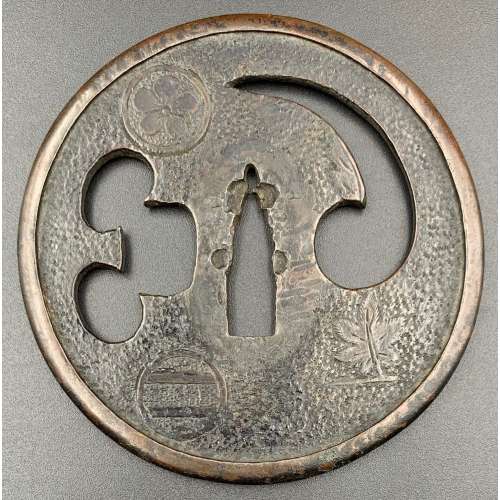
Yamagane (bronze) tsuba (kagamishi, or mirror-maker) with the design of tomoe (comma) and suhama in openwork. Surface treated with hammer marks and chiselled with the design of maple leaves and encircled two bars (maru-ni-futatsu-biki, Ashikaga clan family crest, or mon) on both sides. Raised rim or rim cover (fukurin). Custom kiri-wood box.
Size: 87.4 x 86.2 x 2.9 (center), 4.9 (rim) mm; weight: 120 g. -
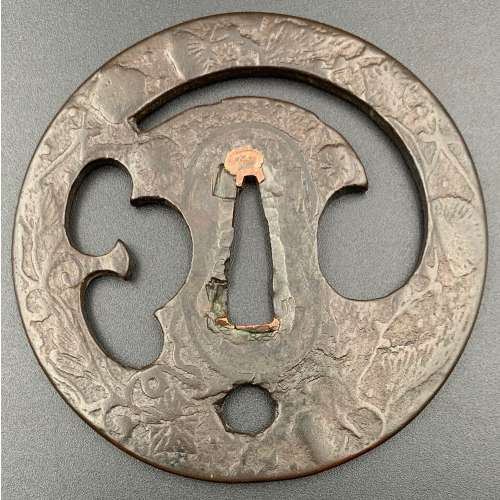
Yamagane (bronze) tsuba (kagami-shi, or mirror-maker) with the design of a star (round opening), tomoe (comma), and suhama in openwork. Surface cast and chiselled with the design of foliage, vines, blossoms, pine needles, and fruits on both sides.
The end of Early Muromachi period (1393-1453), circa 1450. Size: 83.7 x 84.1 x 3.6 (center), 4.1 (rim) mm; weight: 135.5 g. KANTEI-SHO (鑑定書) - APPRAISAL [translated by Markus Sesko]. No 463341 Tomoe-suhama-sukashi hana-karakusa no zu tsuba (巴洲浜透花唐草図鐔) ‒ Tsuba with stylized comma and bay inlet openwork and a flower and arabesque décor Unsigned: Kagami-shi (鏡師) Round shape, yamagane, hammer blow finish, cast, negative openwork design, round rim. According to the result of the shinsa committee of our society, we judge this work as authentic and rank it as Hozon Tōsōgu. July 1, 2011 [Foundation] Nihon Bijutsu Tōken Hozon Kyōkai, NBTHK (日本美術刀劍保存協會) -
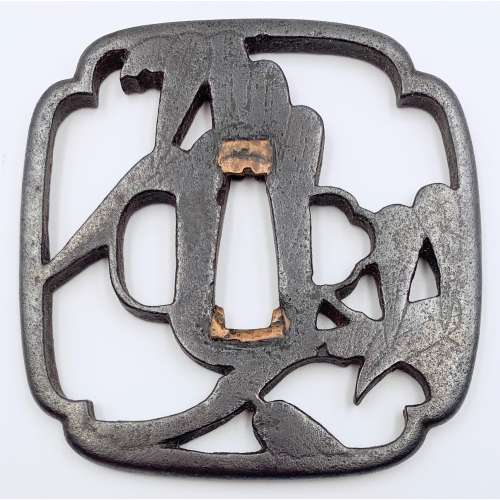 Iron tsuba of quatrefoil form with design of bamboo stems and leaves in openwork (sukashi) decorated with carving (kebori) . Copper sekigane. Early Edo period, late 17th century (Kanbun / Enppo era). First generation Kanshiro of Nishigaki school in Higo Province died in the sixth year of Genroku, 1693, at the age of 81). Height: 74.4 mm; Width: 74.2 mm; Centre thickness: 4.9 mm. Rounded rim. The design was quite popular among the Higo masters.
Iron tsuba of quatrefoil form with design of bamboo stems and leaves in openwork (sukashi) decorated with carving (kebori) . Copper sekigane. Early Edo period, late 17th century (Kanbun / Enppo era). First generation Kanshiro of Nishigaki school in Higo Province died in the sixth year of Genroku, 1693, at the age of 81). Height: 74.4 mm; Width: 74.2 mm; Centre thickness: 4.9 mm. Rounded rim. The design was quite popular among the Higo masters.
Kanshiro III, early 18th century (Sasano 1994 №267)

Matashichi I, late 17th century (Sasano 1994 №270)
The design of my tsuba closely resembles the one at the last example (Sasano 1994 №280), however, the form (mine is quatrefoil) and the execution (strength) are very different, which result in a very different spirit of my piece.
Shigemitsu II, early 18th century (Sasano 1994 №280)
-
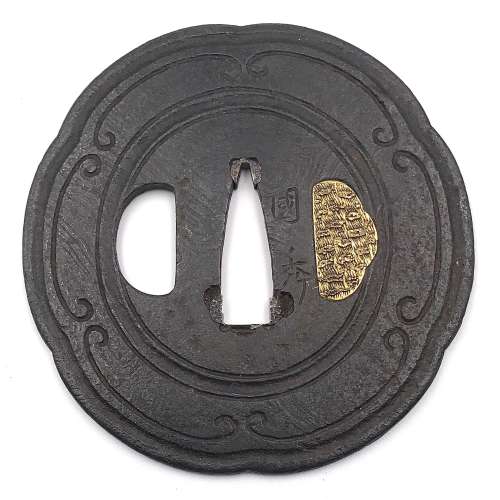
Thin six-lobed iron plate of brownish color is carved on each side with a groove that follows the rim and a concentric grooves around the center of the plate, also carved with six thin scroll lines (mokkō or handles, kan) that follow the shape of the rim. Mokume surface treatment. Hitsu-ana possibly added at a later date, and kogai-hitsu-ana plugged with gold. Silver sekigane.
Signed: Kunihide [國秀]. Higo school, 1st generation swordsmith.
Mid Edo period, ca. 1800.
Would be possibly attributed to Kamakura-bori school revival of the 19th century.
References: Nihon Tō Kōza, Volume VI / Japanese Sword / Kodōgu Part 1, page 231: Enju Kunihide, a tōshō from Higo: "...forging of the jigane is excellent, and there are also pieces with mokume hada."
Haynes Index Vol. 1, p. 741, H 03569.0: "Enju Kunihide in Higo province, died 1830, student of Suishinshi Masahide. Retainer of the Hosokawa Daimyō, etc."
Additional Information from Markus Sesko: This tsuba indeed is made by Enju Kunihide, who in his later years signed the HIDE [秀] character as HI [日] and DE [出], as here: Size: 77.4 x 74.9 x 2.7 mm
Similar pieces are:
1. In this collection № TSU-0341: Kamakura-bori tsuba with mokkō motif. Muromachi period, 15th - 16th century.
2. Dr. Walter A. Compton Collection, 1992, Christie’s auction, Part II, pp. 14-15, №16: “A kamakurabori type tsuba, Muromachi period, circa 1400. The thin, six-lobed iron plate is carved on each side with a wide groove that follows the shape of the rim, and with six scroll lines and a single thin circular groove. […] The hitsu-ana was added at a later date, circa 1500-1550. Height 8.3 cm, width 8.6 cm, thickness 2.5 mm. The tsuba was initially intended to be mounted on a tachi of the battle type in use from Nambokucho to early Muromachi period (1333-1400)”. Sold at $935.
Size: 77.4 x 74.9 x 2.7 mm
Similar pieces are:
1. In this collection № TSU-0341: Kamakura-bori tsuba with mokkō motif. Muromachi period, 15th - 16th century.
2. Dr. Walter A. Compton Collection, 1992, Christie’s auction, Part II, pp. 14-15, №16: “A kamakurabori type tsuba, Muromachi period, circa 1400. The thin, six-lobed iron plate is carved on each side with a wide groove that follows the shape of the rim, and with six scroll lines and a single thin circular groove. […] The hitsu-ana was added at a later date, circa 1500-1550. Height 8.3 cm, width 8.6 cm, thickness 2.5 mm. The tsuba was initially intended to be mounted on a tachi of the battle type in use from Nambokucho to early Muromachi period (1333-1400)”. Sold at $935.
 3. And another one in Robert E. Haynes Catalog #9 on page 24-25 under №23: “Typical later Kamakura-bori style work. This type of plate and carving show the uniform work produced by several schools in the Muromachi </em period. Some had brass inlay and others were just carved as this one is. The hitsu are later. Ca. 1550. Ht. 8.8 cm, Th. 3.25 mm”. Sold for $175.
3. And another one in Robert E. Haynes Catalog #9 on page 24-25 under №23: “Typical later Kamakura-bori style work. This type of plate and carving show the uniform work produced by several schools in the Muromachi </em period. Some had brass inlay and others were just carved as this one is. The hitsu are later. Ca. 1550. Ht. 8.8 cm, Th. 3.25 mm”. Sold for $175.

-
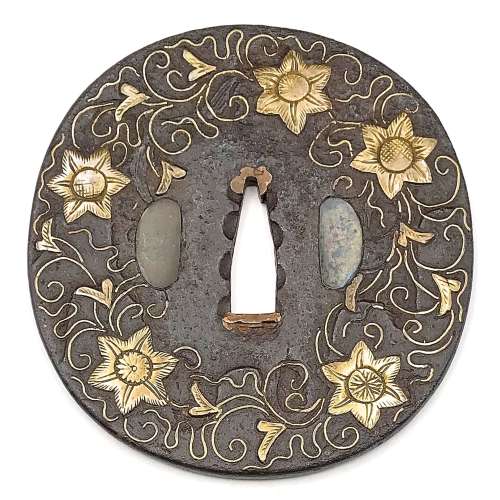
Tsuba of oval form decorated with clematis six-petal flowers, tendrils, and leaves in cast brass with details carved in kebori, inlaid on iron plate carved in low relief (kebori and sukidashi-bori). Hitsu-ana plugged with shakudō. Copper sekigane.
Heianjō (or Ōnin) school. Unsigned. Mid Muromachi period (1454-1513). Dimensions: 87.2 x 84.3 x 4.3 mm. Tsuba is illustrated and described in Gary D. Murtha's "Onin-Heianjo-Yoshiro" book on pages 38-39. Mid-Muromachi is the age attribution by Gary. “A picture book of Japanese sword guards. Victoria & Albert Museum“, published in 1927 presents us with a somewhat similar tsuba: "Floral ornament. Iron, with brass incrustation". V&A attributes the tsuba to Ōnin style, 16th century.
-
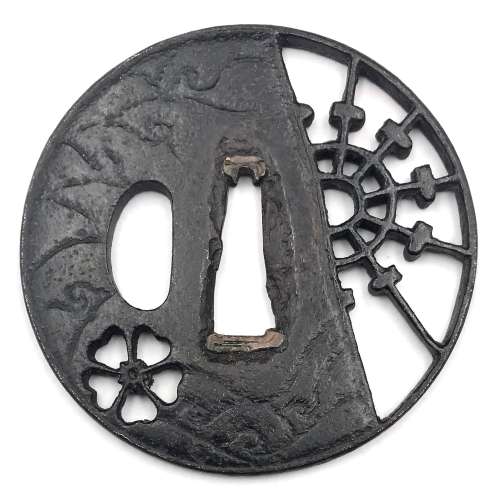 Iron tsuba of round form decorated with design of sea waves in low relief carving (kebori) and pierced with design of cherry blossom in negative silhouette (in-sukashi) and water wheel in positive silhouette (ji-sukashi). The solid portion of the plate has a shallow groove just before the edge. Copper sekigane. School attribution is unclear. Unsigned. Momoyama period, 16th - 17th century. Dimensions: Height: 70.3 mm, width: 71.1 mm, thickness at seppa-dai: 4.4 mm, at rim 4.1 mm. Provenance: Robert E. Haynes, Mark Weisman. This is what shibuiswords.com says about this tsuba:
Iron tsuba of round form decorated with design of sea waves in low relief carving (kebori) and pierced with design of cherry blossom in negative silhouette (in-sukashi) and water wheel in positive silhouette (ji-sukashi). The solid portion of the plate has a shallow groove just before the edge. Copper sekigane. School attribution is unclear. Unsigned. Momoyama period, 16th - 17th century. Dimensions: Height: 70.3 mm, width: 71.1 mm, thickness at seppa-dai: 4.4 mm, at rim 4.1 mm. Provenance: Robert E. Haynes, Mark Weisman. This is what shibuiswords.com says about this tsuba:"A very unusual iron plate tsuba. The solid plate is carved with waves on both sides. A cherry bloom in sukashi, lower left, and the right third of the plate in openwork with design of a water wheel. The rim with some iron bones. The hitsu-ana is original but the shape may have been slightly changed. One would expect this to be the work of the early Edo period, but the age of the walls of the sukashi would suggest that this is a work of the middle Muromachi period. This must be the forerunner for the Edo examples we see of this type of design." (Haynes)
I managed to find a look-a-like tsuba in Haynes Catalog #5, 1983, pp. 20-21, №44: "Typical later Heianjo brass inlay example. Ca. 1725. Ht. 7 cm., Th. 4.5 mm., $100/200".We see that the plate design of both tsuba is the same, and the only difference is the trim. It would be logical to assume that both pieces were made at about the same time, rather than 225 years apart. To be fair, let's accept that they were made in Momoyama period.
Haynes Catalog #5, 1983, pp. 20-21, №44.
-
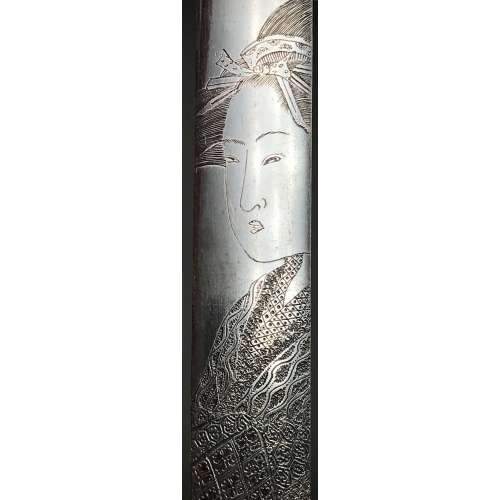 Silver Kozuka carved in kebori ("hair carving") with a ukiyo-e style half-length figure of a beautiful woman (possibly a courtesan) dressed in a splendid kimono and hair ornament (kanzashi). Signed on the back: Koreyasu/Zetai + kaō (是休「花押」) - transcribed by Markus Sesko. Size: 96.8 mm (H) x 14.9 mm (W). Edo period, early 19th century. I managed so far to find the only mention of Koreyasu at Japanese sword-mounts. A descriptive catalogue of the collection of J. C. Hawkshaw, Esq., M.A., of Hollycombe, Liphook. Complied and illustrated by Henri L. Joly. London, 1910 [LIB-1439 in this collection], page 204: 2623. — F./v., nigurome, chased in relief and inlaid with Omori Hikoshichi (large faces). Signed : Koreyasu of Yedo. xix. 2624. — F.K., nigurome, chased and inlaid in relief with Omori Hikoshichi and the witch. Signed : Shinriusha Koreyasu. No pictures of items or signature provided.
Silver Kozuka carved in kebori ("hair carving") with a ukiyo-e style half-length figure of a beautiful woman (possibly a courtesan) dressed in a splendid kimono and hair ornament (kanzashi). Signed on the back: Koreyasu/Zetai + kaō (是休「花押」) - transcribed by Markus Sesko. Size: 96.8 mm (H) x 14.9 mm (W). Edo period, early 19th century. I managed so far to find the only mention of Koreyasu at Japanese sword-mounts. A descriptive catalogue of the collection of J. C. Hawkshaw, Esq., M.A., of Hollycombe, Liphook. Complied and illustrated by Henri L. Joly. London, 1910 [LIB-1439 in this collection], page 204: 2623. — F./v., nigurome, chased in relief and inlaid with Omori Hikoshichi (large faces). Signed : Koreyasu of Yedo. xix. 2624. — F.K., nigurome, chased and inlaid in relief with Omori Hikoshichi and the witch. Signed : Shinriusha Koreyasu. No pictures of items or signature provided. -
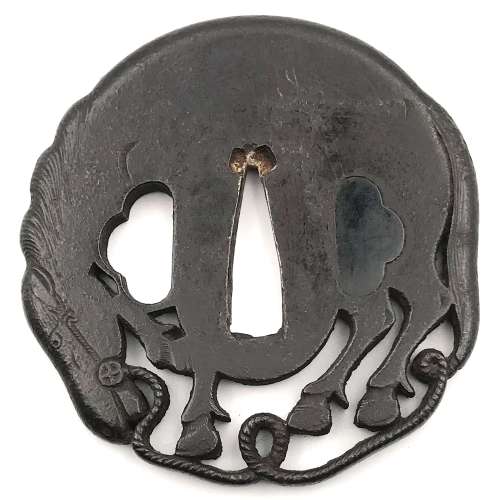
Iron tsuba pierced and carved (marubori-sukashi) with the 'horse in the round' design. Possibly, Bushū-Ito school, 19th century (ca. 1800). Kogai-hitsu-ana plugged with shakudō.
Size: 67.6 x 66.8 x 5.1 mm
Unsigned.
See:
-
- Robert E. Haynes. Study Collection of Japanese Sword Fittings. Nihon Art Publishers, 2010, p. 120: Iron plate carved and formed in the round as a tethered bull...Signed: Bushū jū Sadayasu saku.
- Robert E. Haynes. Masterpiece and highly important tsuba, etc... San Francisco, 1984 // Catalog #9.: Signed: Bushū jū Yoshifusa. Ca. 1800, H 6.7 cm, Th. 4.75 mm.
- The Hartman collection of Japanese metalwork. Christie's, 1976, p. 29, №59: Bushū type, 19th century. Reference to Takezawa, Nihon Toban Zuetsu №411 for a similar design signed Bushū Yoshifusa.
4. Japanese Sword Fittings from the R. B. Caldwell Collection. Sale LN4188 "HIGO". Sotheby's, 30th March 1994, p. 17, №24: An iron tsuba, by Heianjo Sadatsune, Edo period (18th century). In the form of a horse, standing with its head lowered and a rope halter attached to its bit and trailing beneath. Signed Heianjo Sadatsune, 7.3 cm. With NBTHK Tokubetsu kicho paper, dated Showa 49 (1974). GBP 600-700.
Hartman collection, №59.

The Caldwell Collection. Heianjo Sadatsune, Edo period (18th century).
-
-
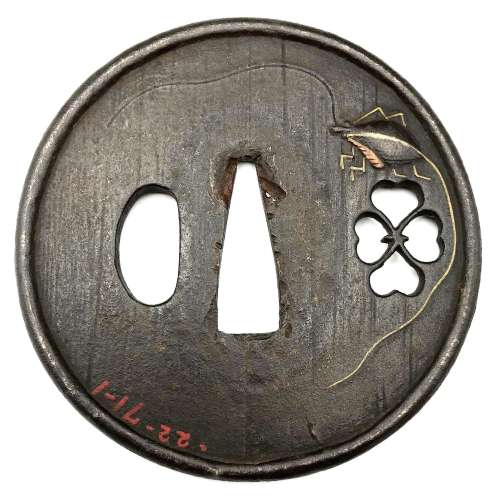 Iron tsuba of round form with a Marsilea (water clover, paddy plant, denjiso) in openwork (sukashi) and a cricket carved in low relief (katakiribori) with extremities and one antenna inlaid with brass; the other antenna is carved in kebori (which antenna is inlaid and which is carved alternates on the face and on the reverse). The plate decorated with vertical file stroke ornamentation (tate-yasurime). Raised dam-shaped rim (dote-mimi). Inscription from a previous collector in red oil paint: 22-71-1. Edo period, possibly 17th century. Katchushi school.
Iron tsuba of round form with a Marsilea (water clover, paddy plant, denjiso) in openwork (sukashi) and a cricket carved in low relief (katakiribori) with extremities and one antenna inlaid with brass; the other antenna is carved in kebori (which antenna is inlaid and which is carved alternates on the face and on the reverse). The plate decorated with vertical file stroke ornamentation (tate-yasurime). Raised dam-shaped rim (dote-mimi). Inscription from a previous collector in red oil paint: 22-71-1. Edo period, possibly 17th century. Katchushi school.Size: 75.0 x 74.4 x 3.6 (center), 5.0 (rim) mm.
The plant Marsilea (paddy plant, denjiso), common names include water clover and four-leaf clover because the long-stalked leaves have four clover-like lobes and are either held above water or submerged. In The elements of Japanese design by John W. Dower, this motif is listed under the numbers 634-35 Paddy Plant (denjiso). Obviously, as a four-leaf clover it is an auspicious symbol. The four leaves radiate out as the shape of the kanji 田 (romaji 'ta'), which means 'rice paddy'. This symbol may be used as a family crest (mon), and this would be the most probable explanation of the sukashi on this tsuba. -
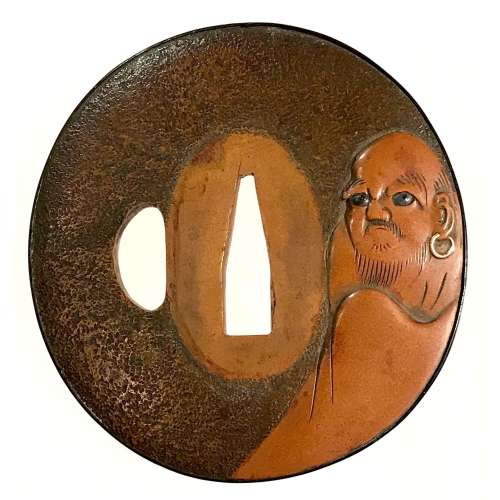
A copper tsuba with ishime-ji ground carved and polished (migaki-ji) with sitting Daruma; his eyes are inlaid with shakudo and he has a golden earring. The reverse carved with four characters: 廓 然 無 性 (Kakunen-mushō). It is a Zen proverb that goes back to Bodhidharma (Daruma), meaning "boundless expanse and nothing that can be called holy." [Markus Sesko translation]. Shakudo fukurin.
Unsigned.
Edo period (circa 1800). Dimensions: 68.2 x 65.5 x 4.8 (center) x 3.2 (rim) mm -
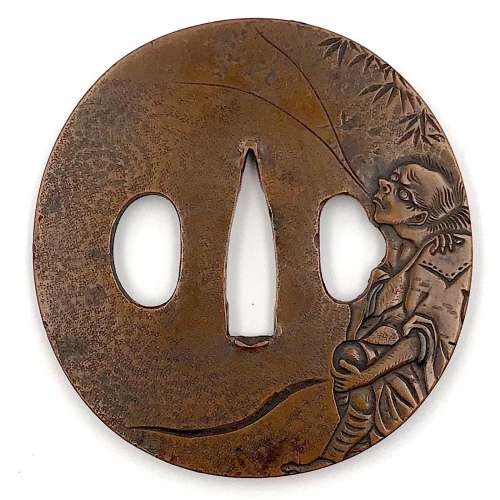
Copper tsuba of oval form carved in kebori and katakiribori with Tekkai Sennin sitting under bamboo on the face and with a pine tree on the back. Ishime-ji treated surface.
Signed on the reverse: Jōi (乗 意).
Edo period (First half of 18th century). Dimensions: 69.6 x 66.5 x 4.5 mm Sugiura Jōi (杉 浦 乗 意) was a master of Nara School in Edo; he was a student of Toshinaga [M. Sesko, 'Genealogies', p. 32]. "Sugiura Jōi (1701-1761) made many fuchigashira and kozuka, tsuba are rather rare." [M. Sesko, The Japanese toso-kinko Schools]. -
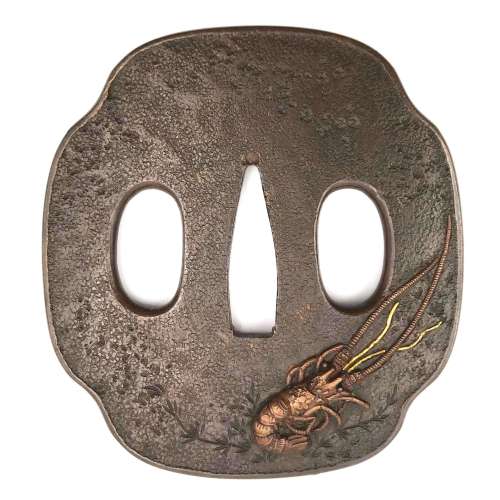
Bronze tsuba of mokkō form with narrow slightly raised rim carved in kebori with the sea weed and inlaid with a lobster (ebi) made of copper on the face and two sea shells made of shakudo on the back. Lobster's antennae inlaid in gold, and eyes inlaid in shakudo. Ishime-ji treated surface.
Unsigned.
Late Edo period (mid-19th century). Dimensions: 76.3 x 71.1 x 3.7 mm -
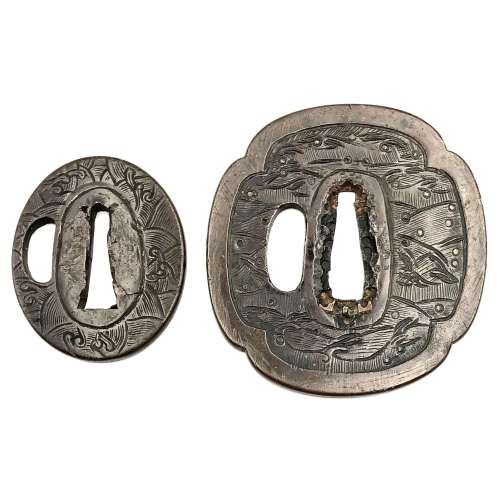 Two ymagane tsuba (daisho) with chiseled diaper pattern of waves. The larger tsuba (dai) is of mokkō form with a wide (4.6 mm) polished rim (fukurin?). Water spray is realized in copper ten-zōgan. Size: 75.0 x 71.6 x 3.2 (center), 4.0 (rim) mm. Copper sekigane. The smaller tsuba (sho) is of oval form, without a rim. No inlay. Size: 53.2 x 45.5 x 4.1 mm. Ko-kinko school. Muromachi period. In Kokusai Tosogu Kai; 5th International Convention & Exhibition, 2009 on page 51 under № 5-U8 there is a piece from George Gaucys collection, described as follows: Unsigned Tachi-Kanagushi tsuba, Yamagane base. Nami (wave) motif. Circa: Muromachi period (15th century). 6.88 x 6.81 x 0.45 (rim), 0.36 (center). The classic wave form is typically seen in Muromachi period tosogu. The patina is rich and rustic, which presents history and warmth. This tsuba may be interpreted as either tachi-kanagushi or ko-kinko work. Early tachi tsuba were symmetrical in design and also not very sophisticated, Design elements filled in up to seppadai as the waves do in this tsuba. There is a simple fikurin of the same metal and it is flat to the plate. On the ko-kinko side, the crests of the waves show more complexity than tachi works and less symmetry. A very intriguing tsuba from late Muromachi period."
Two ymagane tsuba (daisho) with chiseled diaper pattern of waves. The larger tsuba (dai) is of mokkō form with a wide (4.6 mm) polished rim (fukurin?). Water spray is realized in copper ten-zōgan. Size: 75.0 x 71.6 x 3.2 (center), 4.0 (rim) mm. Copper sekigane. The smaller tsuba (sho) is of oval form, without a rim. No inlay. Size: 53.2 x 45.5 x 4.1 mm. Ko-kinko school. Muromachi period. In Kokusai Tosogu Kai; 5th International Convention & Exhibition, 2009 on page 51 under № 5-U8 there is a piece from George Gaucys collection, described as follows: Unsigned Tachi-Kanagushi tsuba, Yamagane base. Nami (wave) motif. Circa: Muromachi period (15th century). 6.88 x 6.81 x 0.45 (rim), 0.36 (center). The classic wave form is typically seen in Muromachi period tosogu. The patina is rich and rustic, which presents history and warmth. This tsuba may be interpreted as either tachi-kanagushi or ko-kinko work. Early tachi tsuba were symmetrical in design and also not very sophisticated, Design elements filled in up to seppadai as the waves do in this tsuba. There is a simple fikurin of the same metal and it is flat to the plate. On the ko-kinko side, the crests of the waves show more complexity than tachi works and less symmetry. A very intriguing tsuba from late Muromachi period."
Kokusai Tosogu Kai 5th, 2009, p. 51, № 5-U8: ko-kinko or tachi-kanagushi tsuba.
-
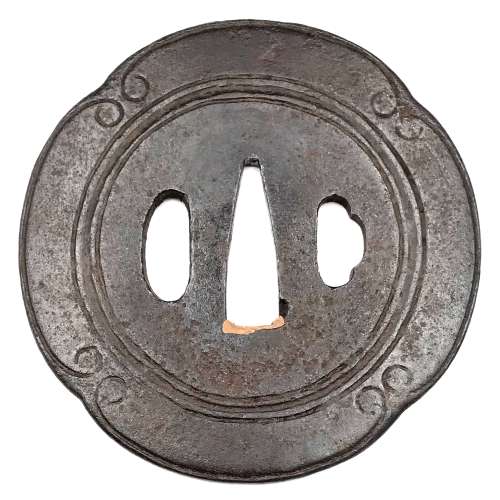 The thin, four-lobed iron plate of brownish color is carved on each side with two concentric grooves in the middle of the web, and with four thin scroll lines (handles, kan) that follow the shape of the rim. The hitsu-ana were added at a later date. Copper sekigane. Kamakura-bori school. Muromachi period, circa 1400-1550. Size: Height 80.4 mm, width 79.0 mm, thickness 3.2 mm at seppa-dai and 2.7 mm at the rim. Weight: 97.7 g. NBTHK Certificate №4004241: 'Hozon' attestation. As for the motif: the concentric circles is a widespread and generic design. It is described by John W. Dower [The Elements of Japanese Design, 1985, p. 132, #2201-30] as follows: Circle: Enclosure (wa). As a crest by itself, the cirlce carries obvious connotations of perfection, harmony, completeness, integrity, even peace. [...] Ordinary circles are labeled according to their thickness, with terminology ranging from hairline to "snake's eye". The motif that is described by both Compton Collection and R.E. Haynes as "scrolls", presented by John W. Dower as "Handle (kan): Although probably a purely ornamental and nonrepresentational design in origin, over the centuries this motif acquired the label kan, denoting its resemblance to the metal handles traditionally used on chests of drawers. [...] Very possibly the "handle" motif represents an early abstract version of the popular mokko, or melon pattern." Early Chinese Taoists claimed that special melon was associated with the Eastern Paradise of Mount Horai just as life-giving peaches were associated with the Western Paradise of the Kunlun Mountains. [...] A design motif called mokko (also translated as "melon" in accordance with the two ideographs with which it is written) may have nothing to do with the fruit. Mokko designs... are widely used as crests of both private families and Shinto shrines and are repeated as background designs that evoke a sense of classicism" [Symbols of Japan. Merrily Baird, 2001]. There is a look alike tsuba at Dr. Walter A. Compton Collection, 1992, Christie’s auction, Part II, pp. 14-15, №16:
The thin, four-lobed iron plate of brownish color is carved on each side with two concentric grooves in the middle of the web, and with four thin scroll lines (handles, kan) that follow the shape of the rim. The hitsu-ana were added at a later date. Copper sekigane. Kamakura-bori school. Muromachi period, circa 1400-1550. Size: Height 80.4 mm, width 79.0 mm, thickness 3.2 mm at seppa-dai and 2.7 mm at the rim. Weight: 97.7 g. NBTHK Certificate №4004241: 'Hozon' attestation. As for the motif: the concentric circles is a widespread and generic design. It is described by John W. Dower [The Elements of Japanese Design, 1985, p. 132, #2201-30] as follows: Circle: Enclosure (wa). As a crest by itself, the cirlce carries obvious connotations of perfection, harmony, completeness, integrity, even peace. [...] Ordinary circles are labeled according to their thickness, with terminology ranging from hairline to "snake's eye". The motif that is described by both Compton Collection and R.E. Haynes as "scrolls", presented by John W. Dower as "Handle (kan): Although probably a purely ornamental and nonrepresentational design in origin, over the centuries this motif acquired the label kan, denoting its resemblance to the metal handles traditionally used on chests of drawers. [...] Very possibly the "handle" motif represents an early abstract version of the popular mokko, or melon pattern." Early Chinese Taoists claimed that special melon was associated with the Eastern Paradise of Mount Horai just as life-giving peaches were associated with the Western Paradise of the Kunlun Mountains. [...] A design motif called mokko (also translated as "melon" in accordance with the two ideographs with which it is written) may have nothing to do with the fruit. Mokko designs... are widely used as crests of both private families and Shinto shrines and are repeated as background designs that evoke a sense of classicism" [Symbols of Japan. Merrily Baird, 2001]. There is a look alike tsuba at Dr. Walter A. Compton Collection, 1992, Christie’s auction, Part II, pp. 14-15, №16: The description goes: “A kamakurabori type tsuba, Muromachi period, circa 1400. The thin, six-lobed iron plate is carved on each side with a wide groove that follows the shape of the rim, and with six scroll lines and a single thin circular groove. […] The hitsu-ana was added at a later date, circa 1500-1550. Height 8.3 cm, width 8.6 cm, thickness 2.5 mm. The tsuba was initially intended to be mounted on a tachi of the battle type in use from Nambokucho to early Muromachi period (1333-1400)”. Sold at $935.
And another one in Robert E. Haynes Catalog #9 on page 24-25 under №23:
The description goes: “A kamakurabori type tsuba, Muromachi period, circa 1400. The thin, six-lobed iron plate is carved on each side with a wide groove that follows the shape of the rim, and with six scroll lines and a single thin circular groove. […] The hitsu-ana was added at a later date, circa 1500-1550. Height 8.3 cm, width 8.6 cm, thickness 2.5 mm. The tsuba was initially intended to be mounted on a tachi of the battle type in use from Nambokucho to early Muromachi period (1333-1400)”. Sold at $935.
And another one in Robert E. Haynes Catalog #9 on page 24-25 under №23:
 R.E. Haynes description: “Typical later Kamakura-bori style work. This type of plate and carving show the uniform work produced by several schools in the Muromachi period. Some had brass inlay and others were just carved as this one is. The hitsu are later. Ca. 1550. Ht. 8.8 cm, Th. 3.25 mm”. Sold for $175.
R.E. Haynes description: “Typical later Kamakura-bori style work. This type of plate and carving show the uniform work produced by several schools in the Muromachi period. Some had brass inlay and others were just carved as this one is. The hitsu are later. Ca. 1550. Ht. 8.8 cm, Th. 3.25 mm”. Sold for $175.
-
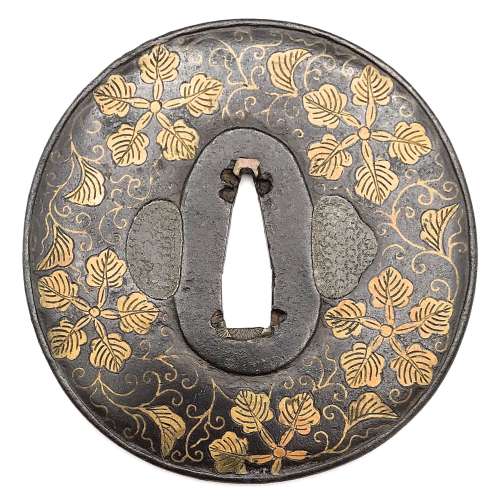 Iron tsuba of slightly elongated round form decorated with design of melon flowers, vines, and leaves in brass flat inlay (hira-zōgan) on both sides. Slightly raised rim (mimi) carved in a way to simulate ring-shaped covering (fukurin). Kozuka hitsu-ana and kogai hitsu-ana both plugged with soft metal (tim or lead). Copper sekigane. Heianjō or Kaga School. Muromachi or Momoyama period, 16th century. Iron, hira-zōgan brass inlay. Round (maru gata) form, diameter 79 mm. Size: 80.3 x 78.4 mm; thickness at seppa-dai: 3.4 mm; at the middle: 3.8 mm; before the rim: 2.4 mm, rim: 2.8 mm. Note on design: though this design resembles family crests with oak and mulberry leaves, I believe it's a melon flower [see Jeanne Allen. Designer's guide to Samurai Patterns. Chronicle Books, San Francisco, 1990, page 114, №130 "Melon Flowers":Note about the distribution of thickness (niku-oki): "this tsuba has toroid features, niku raises from the rim towards the centre but thins once more out when approaching the seppa-dai" [M. Sesko, "Handbook...", p. 48].
Iron tsuba of slightly elongated round form decorated with design of melon flowers, vines, and leaves in brass flat inlay (hira-zōgan) on both sides. Slightly raised rim (mimi) carved in a way to simulate ring-shaped covering (fukurin). Kozuka hitsu-ana and kogai hitsu-ana both plugged with soft metal (tim or lead). Copper sekigane. Heianjō or Kaga School. Muromachi or Momoyama period, 16th century. Iron, hira-zōgan brass inlay. Round (maru gata) form, diameter 79 mm. Size: 80.3 x 78.4 mm; thickness at seppa-dai: 3.4 mm; at the middle: 3.8 mm; before the rim: 2.4 mm, rim: 2.8 mm. Note on design: though this design resembles family crests with oak and mulberry leaves, I believe it's a melon flower [see Jeanne Allen. Designer's guide to Samurai Patterns. Chronicle Books, San Francisco, 1990, page 114, №130 "Melon Flowers":Note about the distribution of thickness (niku-oki): "this tsuba has toroid features, niku raises from the rim towards the centre but thins once more out when approaching the seppa-dai" [M. Sesko, "Handbook...", p. 48].
Jeanne Allen. Designer's guide to Samurai Patterns. Chronicle Books, San Francisco, 1990. Page 114, №130.


